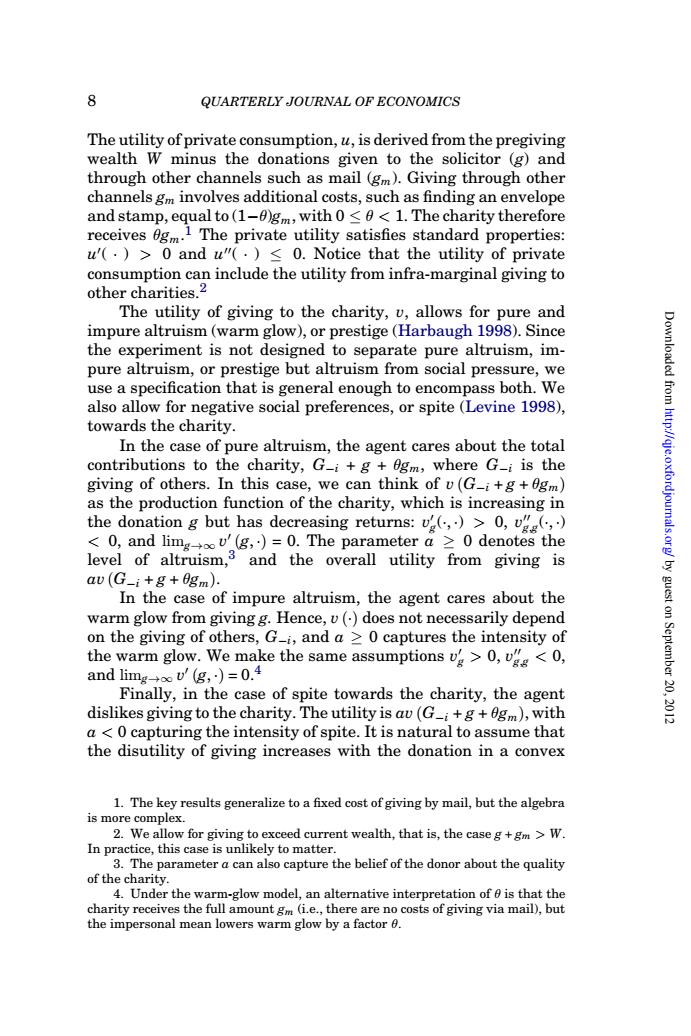正在加载图片...

8 QUARTERLY JOURNAL OF ECONOMICS sumption,u,is derived from the pregiving wealth minus the donations given to the solicitor (g)and through other channels such as mail(gm).Giving through other channels gm involves additional costs,such as finding an envelope and stamp,equalto(1-0)gmm,with0<6<1.The charity therefore receives 0g The private utility satisfies standard properties: u'(.)>0 and u"(.)<0.Notice that the utility of ivate consumption can include the utility from infra-marginal giving to other charities. The utility of giving to the charity,v,allows for pure and impure altruism(warm glow),or prestige(Harbaugh 1998).Since the experiment is not designed to separate pure altruism,im pure altrui but altruis from s cial e a spe fication both.W enough to encompass also allow for negative social preferences,or spite (Levine 1998), towards the charity. In the case of pure altruism.the agent cares about the total contributions to the charity,G-i+g+0gm where G:is the givi g of oth In this of v(G-i+g+0gm as the e producti nctio n of the is incr the donation g but has decreasing returns:v(,)>0,v(,) <0,and limg(g,)=0.The parameter a >0 denotes the level of altruism,3 and the overall utility from giving is av(G-i+g+0gm). In the case of impure altruism,the agent cares about the warm glow vingg.Hence,v()does no t nece sarily depend on the giving of others,G-i,and a >0 captures the intensity of the warm glow.We make the same assumptions v>0,<0, and lim 。w'(g..)=0 Finally,in the case of spite towards the charity,the agent dislikes giving to the charity The utilityis(G i+g+egm),with <0 cap the e intensity of spite.I u04 sume tha the disutility of giving increases with the donation in a convex L.The ke is more yesutsgeneraiaetoaiadoastofgiingbymalbuthealebrn 2.We allow for giving to exceed current wealth,that is,the caseg+gm W. In prac Th e,this case is u y to ma of the charity. the belief of the donor about the quality charit Under the8 QUARTERLY JOURNAL OF ECONOMICS Theutilityofprivateconsumption, u, is derivedfromthepregiving wealth W minus the donations given to the solicitor (g) and through other channels such as mail (gm). Giving through other channels gm involves additional costs, such as finding an envelope andstamp, equal to(1−θ)gm, with0 ≤ θ < 1. Thecharitytherefore receives θgm. 1 The private utility satisfies standard properties: u0 ( ∙ ) > 0 and u00( ∙ ) ≤ 0. Notice that the utility of private consumption can include the utility from infra-marginal giving to other charities.2 The utility of giving to the charity, v, allows for pure and impure altruism (warm glow), or prestige (Harbaugh 1998). Since the experiment is not designed to separate pure altruism, impure altruism, or prestige but altruism from social pressure, we use a specification that is general enough to encompass both. We also allow for negative social preferences, or spite (Levine 1998), towards the charity. In the case of pure altruism, the agent cares about the total contributions to the charity, G−i + g + θgm, where G−i is the giving of others. In this case, we can think of v (G−i + g + θgm) as the production function of the charity, which is increasing in the donation g but has decreasing returns: v0 g(∙, ∙) > 0, v00 g,g(∙, ∙) < 0, and limg→∞ v0 (g, ∙) = 0. The parameter a ≥ 0 denotes the level of altruism,3 and the overall utility from giving is av (G−i + g + θgm). In the case of impure altruism, the agent cares about the warm glowfrom giving g. Hence, v (∙) does not necessarily depend on the giving of others, G−i, and a ≥ 0 captures the intensity of the warm glow. We make the same assumptions v0 g > 0, v00 g,g < 0, and limg→∞ v0 (g, ∙) = 0.4 Finally, in the case of spite towards the charity, the agent dislikes givingtothecharity. Theutilityis av (G−i + g + θgm), with a < 0 capturing the intensity of spite. It is natural toassume that the disutility of giving increases with the donation in a convex 1. The key results generalize to a fixed cost of giving by mail, but the algebra is more complex. 2. We allow for giving to exceed current wealth, that is, the case g + gm > W. In practice, this case is unlikely to matter. 3. The parameter a can also capture the belief of the donor about the quality of the charity. 4. Under the warm-glow model, an alternative interpretation of θ is that the charity receives the full amount gm (i.e., there are no costs of giving via mail), but the impersonal mean lowers warm glow by a factor θ. by guest on September 20, 2012 http://qje.oxfordjournals.org/ Downloaded from